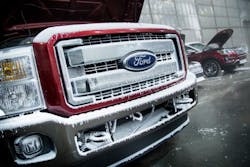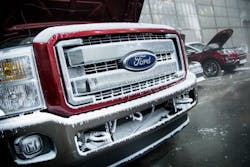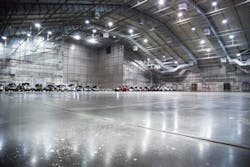Florida would seem to be an unlikely candidate for extreme cold-weather vehicle testing – down to the likes of minus 40 degrees Fahrenheit, similar to the temperatures experienced in the Arctic climes of Alaska’s Prudhoe Bay or Canada’s Yellowknife region.
Yet that’s what the McKinley Climatic Laboratory at Eglin Air Force Base is designed to do – despite being located smack dab in the middle of the Florida panhandle.Conceived during World War II and completed in 1947, the McKinley lab provides facilities for all-weather testing of weapons and ancillary equipment to ensure their function regardless of climatic conditions. The facility can recreate nearly every weather condition that exists on Earth with temperatures ranging from minus 70 to plus 180 degrees Fahrenheit.
Ford Motor Co. recently showed off how it uses the McKinley lab for cold-weather testing of vehicles such as its Super Duty pickup truck, as well as other models.
The reason Ford uses the McKinley lab is because the site can accommodate 75 global prototype vehicles of all sizes for testing, while providing housing for up to 54 engineers and technical experts.
The lab’s size and speedy all-weather capability – it can get temperatures down to minus 40 in 10 hours – allows Ford’s engineers to gather multiple data sets in just three weeks in what could take twice as long at a smaller facility, the OEM noted.
The company added that the data-gathering and analyzing capability at the McKinley facility helps shorten its vehicle development cycle and quickly implement changes.
In short, Ford said that when it’s the middle of a development cycle, or the middle of summer, and there’s no access to a natural environment where engineers can evaluate whether a vehicle is starting as robustly as it should in below-freezing temperatures, the McKinley lab provides those specific conditions so the OEM’s vehicle engineers can simulate, calibrate and validate – all under one roof.
There are significant safety implications behind such climate testing, too. For example, Ford noted that in the oil fields of Alaska’s Prudhoe Bay, trucks are not only a mode of transportation, but also a safety device for workers who need a warm cabin to retreat to on-site to prevent cold-weather injury on the job.Thus at the McKinley lab, Ford said its engineers conduct long-term engine idling tests – running the engine week after week as temperature fluctuates from 40 degrees to minus 40 degrees, and examining the exhaust as it heats up then cools back down.
In another test example, as temperatures in the lab drop to minus 22 degrees, Ford noted that its engineers study the potential volatility of 13 different types of fuel commonly used by customers all over the world in order to better calibrate vehicle cold-start performance.
In terms of what kinds of alternations Ford made to its vehicles as a result of such testing, the OEM said it found that replacing metallic plugs with ceramic gold plugs within its 6.7-liter diesel engine enabled it to heat up more quickly for what the company calls a “more robust start.”
And perhaps the best part is, at the end of a day spent at minus 40 degrees, you can be back in summer temperatures almost instantaneously – something that can’t be done during “real-word” cold testing exercises.


